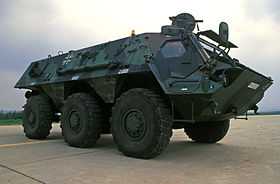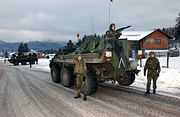TPz Fuchs
| TPz Fuchs | |
|---|---|
|
TPz 1A3 Fuchs NBC reconnaissance vehicle | |
| Type | Armoured Personnel Carrier |
| Place of origin | West Germany |
| Service history | |
| Used by | Bundeswehr |
| Production history | |
| Manufacturer | Thyssen-Henschel |
| Produced | 1979–present |
| Specifications | |
| Weight | 18.3 t |
| Length | 7.33 m (24 ft 1 in) |
| Width | 2.98 m (9 ft 9 in) |
| Height | 2.37 m (7 ft 9 in) |
|
| |
Main armament | Up to three Rheinmetall MG3 |
Secondary armament | MILAN anti-tank guided missile, smoke grenade launchers |
| Engine |
Mercedes-Benz Model OM 402A V-8 liquid-cooled diesel 320 hp |
| Payload capacity | 6 t |
| Suspension | 6×6 |
Operational range | 800 km (500 mi) |
| Speed |
105 km/h (65 mph) 10 km/h (6.2 mph) in water |
| ||||||||||||||||||||||||||||||||||||||||||||||||||||||||||
TPz (Transportpanzer) Fuchs ("fox") is an armoured personnel carrier developed by Daimler-Benz and built by Thyssen-Henschel (now Rheinmetall Landsysteme) in 1979. It was the second wheeled armoured vehicle to be fielded by the Bundeswehr. It is used for tasks including troop transport, engineer transport, bomb disposal, NBC (Nuclear, Biological and Chemical) reconnaissance and electronic warfare. In selecting models and retrofit kits, more than 90 combinations are possible; 32 have been produced. The TPz Fuchs is thus referred to as a "retrofit platform".
The engine is a Mercedes-Benz Model OM 402A V-8 liquid-cooled 320 HP diesel. Its top speed is 105 km/h and the range is 800 km. It is 7.33 m long, 2.98 m wide and 2.37 m high. It weighs 18.3 tons with the capability to carry 6 tons in equipment. The 6x6 APC has high performance over many terrains, with low noise. Its rear-mounted propellers with 360° turning range enabled it to negotiate water obstacles at 10 km/h up to a certain weight limit which an upgraded and loaded Fuchs can easily exceed.
Armament
The TPz Fuchs can be equipped with three Rheinmetall MG3 general purpose machine guns, one of which is mounted on a manually controlled turret.
Fuchs vehicles of the Armoured Reconnaissance Battalion, Panzergrenadiers mechanized infantry, the Franco-German Brigade, the mountain infantry and the Jäger (rangers) of the German Army are armed with MILAN anti-tank-guided missiles and a maximum of two MG3s. Fuchs vehicles deployed in Afghanistan were equipped with a GMG grenade launcher or a M2 Browning heavy machine gun instead of an MG3.
Improvements over the years
Improvements concentrated on the ability to withstand high-performance, armour-piercing ammunition fired from small arms and lightweight carriage-mounted machine guns, as well as shrapnel (e.g. from artillery rounds), and anti-personnel and antitank mines.
Due to the weight and volume restrictions, advanced armour materials are used to meet the protection specifications, which compared to equally effective steel or aluminum alloy armour, can reduce weight by 50%.
The modular armour protection system has six elements:
- Add-on armour mounted to the exterior of the vehicle housing
- Anti-mine protective plating in the wheel cases
- Reinforced bullet-proof windows
- Reinforced bullet-proof visors for shielding the window exteriors
- Spall-lining of all interior surfaces of the vehicle compartment
- A shielded gun mounting (except on the medical vehicles)
Users
Most vehicles are in service with the German Army (1,003 – 144 upgraded), the rest are in the armed forces of Saudi Arabia (36), The Netherlands (23), USA (123, as M93 Fox) and Venezuela (10). The Fuchs served in the Gulf war, in peace-keeping operations with German KFOR troops in the former Yugoslavia and with German ISAF in Afghanistan. The United Kingdom operated 11 vehicles until 2011 at which point they were placed into storage, when the Joint Chemical, Biological, Radiation and Nuclear Regiment ceased to exist. They will be used again by Falcon Squadron, Royal Tank Regiment.[1]
With the cooperation of Germany, an Algerian-German joint venture was created in Algeria to locally produce the Fuchs armored personnel carrier. People's National Army plans to acquire up to 1200 Fuchs.[2]
-
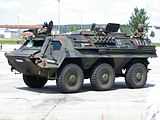
-
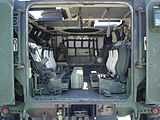
-
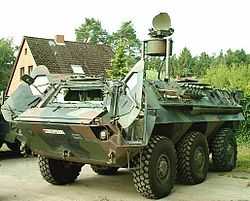
Fuchs with Radar equipment RASIT
-
In British service
M93 Fox
| M93 Fox | |
|---|---|
|
| |
| Type | NBC reconnaissance vehicle |
| Place of origin |
|
| Service history | |
| Used by | United States |
| Wars | Persian Gulf War and Operation Iraqi Freedom |
| Production history | |
| Designer | Thyssen-Henschel |
| Manufacturer | Rheinmetall |
| Variants | XM93, M93A1 |
| Specifications | |
| Weight | 17 tons |
| Length | 22.25 ft |
| Height | 8.1 ft |
| Crew | 3 |
|
| |
| Engine |
Mercedes-Benz Model OM 402A V8 liquid-cooled diesel 320 hp |
| Suspension | 6x6 wheeled |
| Speed | 100 km/h (65 mp/h) |
The Fox (M93, M93A1, and M93A1P1) vehicle is the TPz1 Fuchs variant for chemical, biological, radiological, and nuclear (CBRN) reconnaissance. It is manufactured by Rheinmetall to survive and provide reconnaissance on a CBRN-affected battlefield. It is currently undergoing a retrofit program to improve the survivability and relevance on the modern battlefield. In addition to the survivability upgrade, the mass spectrometer has the added capacity to identify numerous industrial chemical hazards. This allows the reconnaissance section to identify any environmental hazards (TIC/TIM) in its area of operations. The new US Army Stryker vehicle CBRN variant began to supplement/replace the Fox in 2007.
History
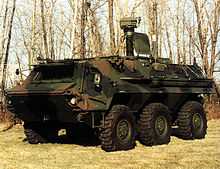
The Fox system was developed originally for use by the German Army; finding itself being requested by the US Military in the late 1980s under the NBCRS-Non-Developmental Item Program. Initially in the first of three phases, 48 working XM93's were delivered under urgent building guidelines, following that issue, another 50 working XM93 models were donated by the German Government for the US Military actions with Operation Desert Storm.[3] The ongoing 'Block 1' modification phase is currently upgrading all previous XM93 models to the M93A1 configuration, which was officially approved for production and fielding in 1995. From January to July 1998 its production qualification runs were completed successfully and the US Army's first productions were equipped with the NBCRS-Fox Block 1 system (M93A1) in October 1998.
- Basis of Issue: 6 per recon platoon (1 platoon per heavy division); 6 per ACR; 2 per separate brigade; additional assets at Corps level
See also
- Boxer (armoured fighting vehicle)
- KMW Grizzly – another new armored vehicle of the German Army
- AGF (Light infantry vehicle)
- Rheinmetall YAK
- ATF Dingo
- Pindad Panser
References
- ↑ http://www.royaltankregiment.com/en-GB/Page/News/98.aspx
- ↑ "Germany Plans Extensive Arms Deal with Algeria". Spiegel. 12 November 2012. Retrieved 24 June 2013.
- ↑ Ripley, Tim (1992). The New Illustrated Guide to the Modern US Army. Salamander Books Ltd. pp. 46–47. ISBN 0-86101-671-8.
External links
| Wikimedia Commons has media related to Transportpanzer 1 Fuchs. |
| ||||||||||||||
